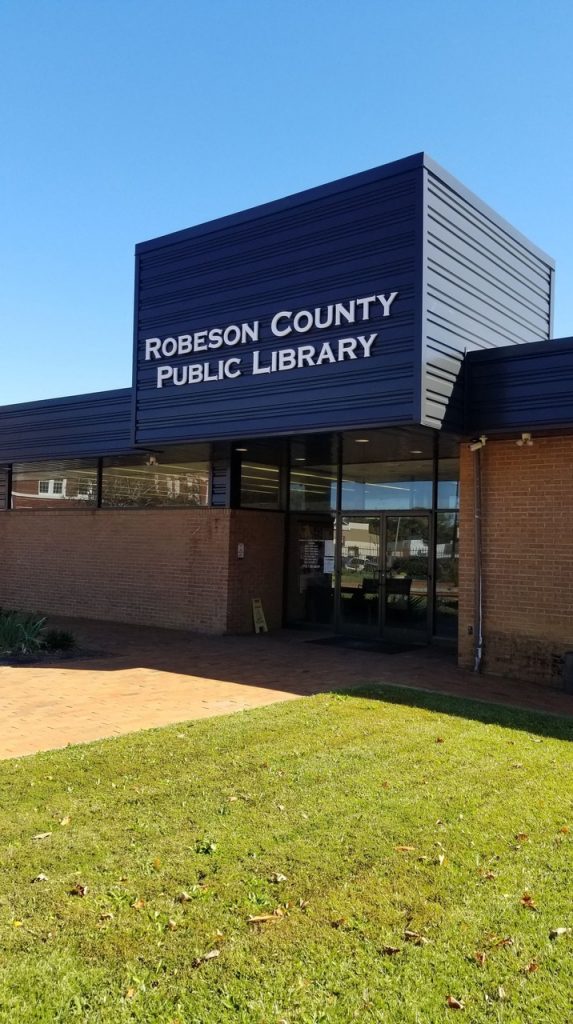
Increasing Access to Literacy and Libraries
for
Lumbee Children and Families
Purpose
Reading Nation Waterfall is a three year federally funded project working with five Native American tribes across the country. The Lumbee Tribe is one of those partners and we are working with the Robenson County Public Library, Pembroke Elementary School, Pembroke Head Start, and Pembroke Boys and Girls Club with three primary goals to: 1) Increase access to books and libraries to children and families, 2) Increase the number of books and reading with parents/adults at home, and 3) Increase relevance and use of libraries for Native American communities. Two primary outcomes are to increase kindergarten entrance and 4th grade reading scores for each partnering tribe. One of our main activities is to provide an unlimited number of free books to children from 0-10 at preschool, elementary school, and their public libraries through strategically placed little free libraries that will be restocked with brand new/gently used librarian curated books every week.
Total Books Disseminated
| Organization | BOOKS DISSEMINATED |
|---|---|
| Pembroke Elementary | 3366 |
| Pembroke Head Start | 3259 |
| Pembroke Boys & Girls Club | 2944 |
| Free Book Fairs | 2741 |
| TOTAL TO DATE (as of June 25, 2024) | 12,310 |
Books Read at Home (RNW Reading Log Program): 2420
Take Home Library Boxes: 400
Little Free Libraries
Lumbee Tribe of North Carolina Partners
| University of North Carolina Pembroke | Robeson County Public Library | Pembroke Elementary School | Pembroke Boys & Girls Club | Pembroke Head Start |
|---|---|---|---|---|
| Heather Kimberly Dial Sellers (Kim) PhD (Lumbee), Program Director Reading Education | Katie Fountain, Director | Ana Locklear, Media Assistant Joanna S. Hunt, Principal | Dr. Rose Marie Lowry-Townsend, Director of Youth Services | Linda Goins, Director |
Visit Your Local Library
Pembroke Branch
413 Blaine St
Pembroke, NC 28372
(910) 521-1554
Robeson County Public Library
101 N. Chestnut St
Lumberton, NC 28358

Lumbee Tribe History and Facts
The Lumbee Tribe of North Carolina calls the area surrounding the Lumber River in Robeson County home. It is situated in the southeastern part of the state along the border with South Carolina. The members mainly reside in Robeson, Hoke, Cumberland, and Scotland counties. Archeological evidence reveals that Native Americans have continuously been in the area that the Lumbee Tribe call home since 12,000 years BC. Some in the Lumbee Tribe can trace their ancestry to the region while others have roots in the tribes that migrated from other parts of the Carolinas and Virginia. At 55,000 members, the Lumbee Tribe is the largest tribe east of the Mississippi and the ninth largest in the nation.
In the early 1700’s, the Lumber River was a destination for those fleeing epidemics, war, and the oppression of native peoples by white colonials. Due to the geographic phenomenon known as Carolina Bays, the land of the Lumbee Tribe was isolated and offered a safe haven for a period of time. People from the Eastern Siouan, Algonquian, and Iroquoian tribes that came to the Lumber River were welcomed and became part of the ancestors of the current Lumbee Tribe of North Carolina.
The native people living by the Lumber River, up until 1835, had some rights as citizens. North Carolina’s government eventually succumbed to racist, anti-native policies and in 1835 the state’s constitution was amended to take away the native people’s right to vote and bear arms. Later when the Civil War began, many Lumbee people were conscripted to manual labor building fortifications for the Confederate Army. After decades of oppression, a group of tribespeople and their allies began to fight back against the Confederate Home Guard after Henry Berry Lowrie’s father and brother were killed by Confederates. This began the Lowrie War and the slow road to the restitution of some rights.
In 1868, North Carolina restored voting rights and the right to bear arms to the Lumbee, yet the struggles to obtain educational rights for their children and their political autonomy continued. After decades of the state legislature trying to dictate the tribe’s name, in 1953 the tribe chose the Lumbee name for themselves.
The Lumbee Tribe has long valued education. It was an integral part of the Lumbee Tribe’s initial pursuance for state and federal recognition. In 1887, legislation was passed for the tribe to establish a school. The Lumbee had funding for teacher salaries, but they secured the rights to the land and built buildings on their own. In 1941, the same school began offering four-year degrees and was named the Pembroke College of Indians. It is now part of the University of North Carolina system and is known as the University of North Carolina Pembroke. The university is a fundamental part of the Lumbee community. It offers a Department of American Indian Studies, employs Lumbee faculty and staff, and curates the on-campus Museum of the Southeast American Indian.
The Lumbee Tribe is self-governed through the work of the Lumbee Tribal Council which consists of 21 members and represents 14 tribal districts. The Tribal Chairman is the political leader of the Lumbee government and represents them in an official capacity. John Lowery is the seventh, and current, Tribal Chairman of the Lumbee people.
Family/Child Literacy Program

At home is where readers are made. Reading Nation Waterfall will provide the books for free but it is essential adults read with their children at home EVERYDAY.
Read
- Spend 15 minutes every day reading – anything! You can read to yourself or read aloud with the family.
- The most powerful ways to encourage young readers are also the simplest: talk with, listen to, read to, and write with your kids.
- Gather a variety of print materials and read them aloud to your child: a recipe, a grocery bill, a calendar, labels, mail, phone messages, signs, magazines, newspapers, games, posters. Even if children do not understand all the words, if they can see the connection between text and your words, and you can both pay attention to the text.
Write
- Provide writing materials: crayons, pencils, charcoal, paper, even backs of mailed paper; have children copy letters or do “pretend” writing.
- Write a new ending for a story you read or heard. Attach a photo to the middle of a paper. To the left of the phone, draw a picture and write what happened before the scene in the picture; then to the right of the photo, draw a picture and write what happened afterwards.
- Collect or draw pictures about a topic such as seasons, animals, colors. Paste them on paper, and caption them.
Talk
- Talk through activities you do. How do you cook, fix a car, do laundry, pull weeds, dress a child?
- Tell stories. Tell a story about your pet or toy; use a stuffed animal to tell a story.
Sing
- Sing songs to a child, and sing songs together.
- Clap or dance to the rhythm of a song.
- Make up new words to a song.
- Make up actions to a song.
Play
- Play nursery rhyme games such as Peek-a-Boo, This Little Piggy, Itsy Bitsy Spider.
- Draw the picture of a character or a place in a story you read or heard.
- Act out a scene or a plot in a book you read or a story you heard.
Oral Stories
Told by: Lynette Dial, Supervisor & Program Coordinator Hoke County Public Library
Filmed by: Francell Productions





















